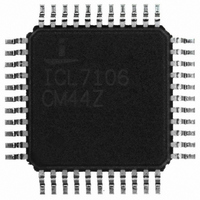ICL7106CM44Z Intersil, ICL7106CM44Z Datasheet - Page 6

ICL7106CM44Z
Manufacturer Part Number
ICL7106CM44Z
Description
IC ADC 3.5 DIGIT LCD/LED 44-MQFP
Manufacturer
Intersil
Datasheet
1.ICL7107CPLZ.pdf
(16 pages)
Specifications of ICL7106CM44Z
Display Type
LCD
Configuration
7 Segment
Digits Or Characters
A/D 3.5 Digits
Voltage - Supply
4.75 V ~ 5.25 V
Operating Temperature
0°C ~ 70°C
Mounting Type
Surface Mount
Package / Case
44-MQFP, 44-PQFP
Lead Free Status / RoHS Status
Lead free / RoHS Compliant
Current - Supply
-
Interface
-
Available stocks
Company
Part Number
Manufacturer
Quantity
Price
Detailed Description
Analog Section
Figure 3 shows the Analog Section for the ICL7106 and
ICL7107. Each measurement cycle is divided into three
phases. They are (1) auto-zero (A-Z), (2) signal integrate
(INT) and (3) de-integrate (DE).
Auto-Zero Phase
During auto-zero three things happen. First, input high and low
are disconnected from the pins and internally shorted to analog
COMMON. Second, the reference capacitor is charged to the
reference voltage. Third, a feedback loop is closed around the
system to charge the auto-zero capacitor C
for offset voltages in the buffer amplifier, integrator, and
comparator. Since the comparator is included in the loop, the A-
Z accuracy is limited only by the noise of the system. In any
case, the offset referred to the input is less than 10µV.
Signal Integrate Phase
During signal integrate, the auto-zero loop is opened, the
internal short is removed, and the internal input high and low
are connected to the external pins. The converter then
integrates the differential voltage between IN HI and IN LO for a
fixed time. This differential voltage can be within a wide
common mode range: up to 1V from either supply. If, on the
other hand, the input signal has no return with respect to the
converter power supply, IN LO can be tied to analog COMMON
to establish the correct common mode voltage. At the end of
this phase, the polarity of the integrated signal is determined.
De-Integrate Phase
The final phase is de-integrate, or reference integrate. Input
low is internally connected to analog COMMON and input
high is connected across the previously charged reference
capacitor. Circuitry within the chip ensures that the capacitor
will be connected with the correct polarity to cause the
integrator output to return to zero. The time required for the
COMMON
IN LO
IN HI
31
32
30
STRAY
V+
10µA
INT
INT
C
A-Z
REF
34
+
6
REF HI
36
DE-
DE+
A-Z
FIGURE 3. ANALOG SECTION OF ICL7106 AND ICL7107
A-Z AND DE(±)
C
AZ
REF
to compensate
ICL7106, ICL7107, ICL7107S
A-Z
DE+
DE
35
REF LO
-
33
N
C
V-
REF
INPUT
-
+
STRAY
HIGH
-
+
-
output to return to zero is proportional to the input signal.
Specifically the digital reading displayed is:
Differential Input
The input can accept differential voltages anywhere within the
common mode range of the input amplifier, or specifically from
0.5V below the positive supply to 1V above the negative
supply. In this range, the system has a CMRR of 86dB typical.
However, care must be exercised to assure the integrator
output does not saturate. A worst case condition would be a
large positive common mode voltage with a near full scale
negative differential input voltage. The negative input signal
drives the integrator positive when most of its swing has been
used up by the positive common mode voltage. For these
critical applications the integrator output swing can be
reduced to less than the recommended 2V full scale swing
with little loss of accuracy. The integrator output can swing to
within 0.3V of either supply without loss of linearity.
Differential Reference
The reference voltage can be generated anywhere within the
power supply voltage of the converter. The main source of
common mode error is a roll-over voltage caused by the
reference capacitor losing or gaining charge to stray capacity
on its nodes. If there is a large common mode voltage, the
reference capacitor can gain charge (increase voltage) when
called up to de-integrate a positive signal but lose charge
(decrease voltage) when called up to de-integrate a negative
input signal. This difference in reference for positive or negative
input voltage will give a roll-over error. However, by selecting the
reference capacitor such that it is large enough in comparison
to the stray capacitance, this error can be held to less than 0.5
count worst case. (See Component Value Selection.)
DISPLAY COUNT = 1000
BUFFER
28
R
INT
2.8V
V+
1
6.2V
29
A-Z
INTEGRATOR
INPUT
LOW
C
AZ
-------------- -
V
V
A-Z
REF
IN
+
-
COMPARATOR
.
27
INT
C
+
-
INT
TO
DIGITAL
SECTION
FN3082.8












